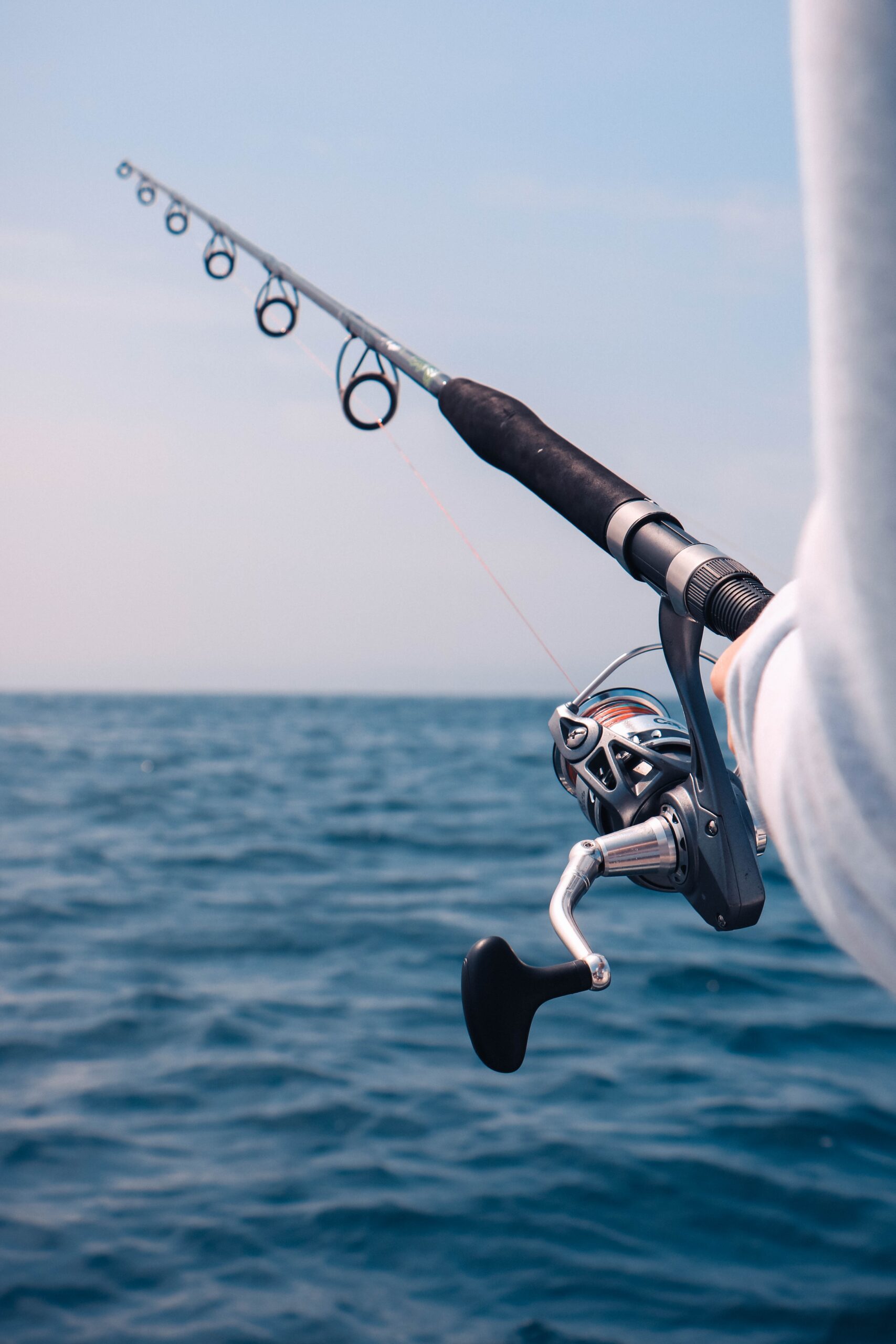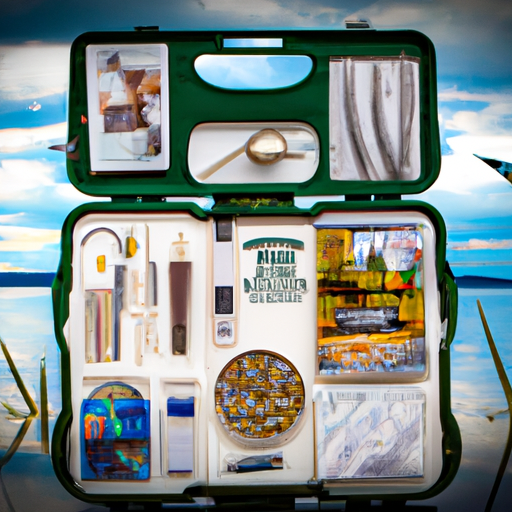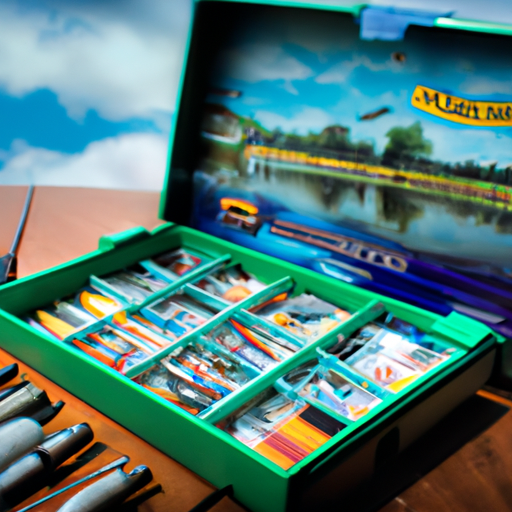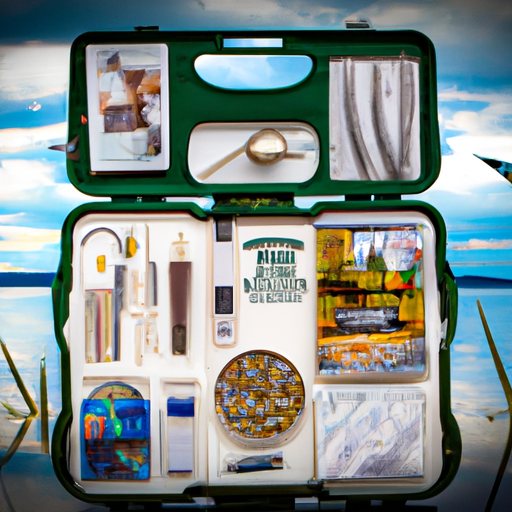Have you recently found yourself drawn to the world of fishing? Perhaps you’ve been intrigued by the idea of spending a peaceful day by the water, casting your line and waiting for that thrilling tug. If you’re new to the sport, one of the first things you’ll need is a well-stocked tackle box. In this article, we’ll explore the essential items every beginner angler should have in their tackle box. From hooks and sinkers to bait and bobbers, we’ll walk you through the must-haves that will help set you up for a successful and enjoyable fishing adventure.

Fishing Rods and Reels
Spinning rods and reels
When it comes to choosing fishing rods and reels, a spinning rod and reel combo is a great option for beginners. The spinning reel is easy to use and offers versatility in terms of the types of fish you can target. The main advantage of a spinning reel is that it allows you to cast lightweight lures and baits with ease. Additionally, it is relatively easy to control the line and handle larger fish.
A spinning rod, on the other hand, is designed to work in tandem with the spinning reel. It is lightweight and flexible, allowing for accurate casting and improved sensitivity. This type of rod and reel combo is suitable for a wide range of fishing scenarios.
Baitcasting rods and reels
Baitcasting rods and reels are another popular option for anglers, especially those with some experience. Baitcast reels are known for their precision and control. They allow for longer casts and provide better accuracy compared to spinning reels. Baitcasting reels also offer increased line capacity, which is important when targeting larger fish.
Baitcasting rods are specially designed to handle the weight and power of baitcasting reels. They are typically stiffer and provide better leverage when reeling in fish. However, baitcasting setups require a bit more practice and skill to master compared to spinning rods and reels. Therefore, they may not be the best choice for beginners who are just starting out.
Fly rods and reels
Fly fishing is a unique and exciting way to catch fish, and it requires specialized equipment. Fly rods and reels are specifically designed for this style of fishing. Fly rods are long and flexible with a lightweight construction, allowing for delicate presentations and accurate casting. They also provide better control when playing fish, which is important as fly fishing often involves catch-and-release.
Fly reels are designed to hold a large amount of fly line and backing. They have a smooth drag system to handle the runs and jumps of fish. The most important factor when choosing a fly reel is matching it to the weight of the fly rod. This ensures a balanced setup that will make casting and fighting fish a breeze.
Fishing Line
Monofilament fishing line
When it comes to fishing line, monofilament is a popular choice among beginners and experienced anglers alike. Monofilament fishing line is made of a single strand of nylon, making it flexible and easy to handle. It offers good knot strength and is relatively inexpensive compared to other types of fishing line.
Monofilament line floats on the water surface, which makes it ideal for topwater fishing. It also has some stretch to it, which can be useful when fighting larger fish or when using lures that require a more subtle presentation. However, it does tend to degrade over time, so it’s important to regularly inspect and change your monofilament line.
Braided fishing line
Braided fishing line is known for its strength and durability. It is made by weaving together multiple strands of synthetic fibers, usually dyneema or spectra. This results in a line that is much stronger and thinner compared to monofilament line. Braided line has little to no stretch, providing excellent sensitivity and immediate hook sets.
Braided line is great for fishing in heavy cover or when targeting larger fish that may put up a strong fight. It also has a high abrasion resistance, making it suitable for fishing in rocky areas. However, due to its low visibility in the water, it may require the use of a leader for certain fishing conditions and species.
Fluorocarbon fishing line
Fluorocarbon fishing line is known for its excellent invisibility underwater. It is made of a polymer material that closely resembles the refractive index of water, making it nearly invisible to fish. Fluorocarbon line also sinks faster than other types of fishing line, which can be beneficial when fishing deeper waters.
One of the main advantages of fluorocarbon line is its high abrasion resistance, making it suitable for fishing in areas with heavy cover. It also has less stretch compared to monofilament line, providing better sensitivity and hook sets. However, fluorocarbon line can be more expensive than other options and may require additional care, such as wetting it before tightening knots to prevent damage.
Hooks
J-hooks
J-hooks are the most common type of hooks used by anglers. As the name suggests, they have a shape resembling the letter “J.” J-hooks are versatile and can be used with various fishing techniques and baits. They work well for both freshwater and saltwater fishing, making them a great choice for beginners.
J-hooks come in different sizes and strengths to accommodate different fish species and fishing conditions. They are most commonly used for live or dead bait fishing, as well as for artificial baits such as soft plastics. When using J-hooks, it’s important to set the hook properly to ensure a solid connection with the fish.
Circle hooks
Circle hooks are gaining popularity among anglers, especially those who practice catch-and-release fishing. Circle hooks have a unique curved shape that forms a circular bend. Unlike J-hooks, circle hooks are designed to hook a fish in the corner of its mouth, reducing the chance of deep hooking and increasing the odds of a successful release.
When using circle hooks, it’s important to let the fish take the bait and allow the hook to set itself. This is why they are often used in passive fishing techniques such as bottom fishing or using live bait. Circle hooks are particularly effective for larger fish species or when fishing in areas with regulations regarding hook type.
Treble hooks
Treble hooks consist of three hooks joined together at a common point. They are commonly used on artificial lures such as crankbaits or topwater lures. Treble hooks provide increased chances of hooking a fish due to the multiple points. However, they can also increase the chances of hooking a fish deep, which may make catch-and-release more difficult.
Treble hooks come in different sizes and strengths to match the size of the lure and the fish species targeted. It’s important to check the fishing regulations and use the appropriate size and type of treble hooks to comply with any size or barb restrictions.
Weights and Sinkers
Split shot sinkers
Split shot sinkers are small lead or non-toxic weights that can be easily attached or removed from the fishing line. They are the most common type of sinker used by anglers, as they provide a quick and easy way to adjust the depth at which your bait or lure is presented. Split shot sinkers are ideal for finesse fishing or when a more subtle presentation is required.
To use a split shot sinker, simply pinch it onto the fishing line above your hook or lure. The placement of the sinker will depend on the desired depth and fishing conditions. Split shot sinkers come in different sizes, allowing for precise adjustments based on your fishing needs.
Bullet weights
Bullet weights are cylindrical or bullet-shaped sinkers primarily used in bass and freshwater fishing. They are usually made of lead, but non-toxic alternatives are also available. Bullet weights are designed to slide freely on the fishing line and are commonly used in Carolina rigs or Texas rigs.
The streamlined shape of bullet weights allows for improved casting distance and accuracy. They also help to ensure that your bait or lure reaches the desired depth quickly. By using different weights, you can easily adjust the sink rate and target fish at different depths.
Drop shot weights
Drop shot weights are commonly used in finesse fishing techniques, such as drop shotting. They are typically small and cylindrical, with a swivel or clip for easy attachment. Drop shot weights are designed to be tied to the end of the fishing line, with the bait or lure tied above it. This setup allows for a vertical presentation, perfect for enticing bottom-dwelling fish.
The main advantage of drop shot weights is that they keep your bait or lure at a specific distance off the bottom, allowing for better control and presentation. They are often used with lightweight or finesse baits, as the weight can be adjusted to match the conditions and the fish’s feeding preferences.

Bobbers
Clip-on bobbers
Clip-on bobbers, also known as float bobbers, are one of the most common types of bobbers used by anglers. They are attached to the fishing line with a spring-loaded clip, making them easy to add or remove as needed. Clip-on bobbers are versatile and can be used with a variety of fishing techniques and baits.
When using a clip-on bobber, you can adjust the depth at which your bait or lure is presented by sliding the bobber up or down the fishing line. The bobber will float on the water surface, indicating when a fish bites. This type of bobber is great for beginners as it provides a visual indication of fish activity and helps with casting accuracy.
Slip bobbers
Slip bobbers, also called sliding bobbers, offer increased versatility compared to clip-on bobbers. They consist of a bobber stop, a bead, and a bobber. Slip bobbers allow you to adjust the depth at which your bait or lure is presented more precisely. The bobber stop can be easily moved up or down the fishing line to change the depth.
The main advantage of slip bobbers is that they allow you to fish at various depths without having to constantly reattach the bobber. This is especially useful when targeting fish that prefer specific depth ranges. Slip bobbers are commonly used in techniques such as float fishing and are ideal for situations where precision and sensitivity are required.
Spring bobbers
Spring bobbers are a specialized type of bobber primarily used by ice anglers. They consist of a flexible spring or wire arm that is attached to the fishing rod. Spring bobbers are extremely sensitive and provide an immediate indication when a fish bites, even the most subtle nibbles.
When using a spring bobber, you simply thread the fishing line through the guides on the rod and allow it to rest on the spring. The flexibility of the spring allows for natural movement of the bait or lure and ensures that you don’t miss any bites. Spring bobbers are ideal for ice fishing as they are easy to use and highly effective in detecting even the lightest movements.
Plastic and Soft Baits
Worms
Worms are one of the most popular and versatile baits used by anglers of all skill levels. They come in various sizes, colors, and shapes, making them suitable for targeting a wide range of fish species. Plastic worms can be rigged in different ways, such as Texas rig, Carolina rig, or wacky rig, to imitate a natural presentation.
The key to using plastic worms effectively is to experiment with different techniques and presentations to find what works best for the fish you are targeting. Slowly twitching or dragging the worm along the bottom can mimic a wounded or feeding prey, making it irresistible to fish. Worms are particularly effective for bass fishing, but many other species also find them enticing.
Crawfish
Crawfish, also known as crayfish or crawdads, are a popular soft bait option for freshwater fishing. They are often used to target bass, trout, and other predatory fish. Crawfish soft baits come in various sizes and colors, imitating the appearance of these crustaceans and enticing fish to strike.
When using crawfish soft baits, it’s important to mimic their natural movement. This can be achieved by slowly dragging the bait along the bottom or hopping it over rocks and structures. Crawfish soft baits can be rigged on a jighead, Texas rig, or Carolina rig, depending on the fishing conditions and the desired presentation.
Minnows
Minnows, both natural and artificial, are a popular bait choice for anglers targeting a wide range of fish species. Live minnows are commonly used in baitfish fisheries and can be an effective option for both freshwater and saltwater fishing. Artificial minnows, also known as swimbaits or jerkbaits, imitate the appearance and movement of live minnows.
When fishing with live minnows, it’s important to use a suitable tackle setup, such as a bobber rig or a live bait rig. Keeping the minnows lively and near the surface or at the desired depth can attract the attention of predatory fish. Artificial minnows can be rigged on a jighead or used as a trailer on a spinnerbait or other lures, providing a lifelike swimming action that can entice strikes.
Hard Baits
Crankbaits
Crankbaits are hard-bodied lures that imitate the movement and appearance of baitfish. They typically feature a lip or bill that causes the lure to dive or wobble when retrieved. Crankbaits come in various shapes, sizes, and colors, allowing for a wide range of fishing applications.
When using crankbaits, it’s important to match the diving depth of the lure to the depth at which the fish are feeding. This can be achieved by choosing crankbaits with different lip sizes or by adjusting the retrieval speed. Crankbaits are effective for targeting a variety of fish species, including bass, walleye, and pike.
Topwater lures
Topwater lures are designed to be fished on the water surface, creating commotion and attracting fish from below. They come in various styles, such as poppers, prop baits, and walk-the-dog lures, each producing a different action and sound. Topwater lures are particularly exciting to fish with, as strikes often happen right before your eyes.
When fishing with topwater lures, it’s important to vary the retrieve speed and action to entice fish. Poppers can be “popped” or “chugged” to create a splashing sound. Prop baits have spinning blades that create a commotion when retrieved. Walk-the-dog lures require a side-to-side motion to imitate a wounded baitfish. Topwater lures are effective for targeting species such as bass, trout, and musky.
Spinnerbaits
Spinnerbaits are versatile lures that consist of a metal blade or blades attached to a wire arm and a skirted jighead. The blades spin when retrieved, creating flash and vibration that can attract fish from a distance. Spinnerbaits come in various sizes, colors, and blade configurations to match different fishing conditions.
When fishing with spinnerbaits, it’s important to experiment with different blade sizes and colors to find what works best for the fish you are targeting. Spinnerbaits are typically retrieved at a steady speed, but variations in the retrieval speed can be used to trigger strikes. They are effective for targeting predatory fish such as bass, pike, and walleye.
Fishing Tools
Pliers
Pliers are an essential tool for every angler. They are used for a variety of tasks, such as removing hooks, crimping split shot sinkers, and cutting fishing line. It’s important to choose pliers specifically designed for fishing, as they often feature a rust-resistant coating and non-slip handles for better grip.
When using pliers, it’s important to handle fish with care to minimize stress and potential harm. Needle-nose pliers are particularly useful for removing hooks from the mouth of a fish without causing unnecessary damage. Having a quality pair of pliers in your tackle box will make your fishing experience more efficient and enjoyable.
Hook removers
Hook removers, also known as hook extractors or dehooking tools, are specifically designed to safely remove hooks from the mouth of a fish. They come in various sizes and styles, allowing for the safe removal of hooks of different shapes and sizes. Hook removers are particularly useful when handling fish with sharp teeth or venomous spines.
Using a hook remover will not only reduce stress and potential injury to the fish, but it will also minimize the chances of getting hooked yourself. Some hook removers feature a locking mechanism that holds the hook securely during the removal process. Investing in a quality hook remover is a wise choice for both the well-being of the fish and your own safety.
Line clippers
Line clippers, also known as line cutters or nippers, are small tools specifically designed to cut fishing line. They provide a clean and precise cut, ensuring that your knots are secure and that the line is properly trimmed. Line clippers are usually compact and can easily fit in your pocket or be attached to a lanyard for quick access.
When using line clippers, it’s important to exercise caution to avoid cutting yourself or damaging the fishing line unnecessarily. Keeping your line clippers sharp will ensure a clean cut without fraying the line. Having a reliable pair of line clippers in your tackle box will save you time and frustration on the water.

First Aid Kit
Band-Aids
A first aid kit is an essential item that every angler should have. Accidents can happen, whether it’s a small cut, a hook embedded in your skin, or a more serious injury. Having a basic first aid kit with items such as Band-Aids is crucial for treating minor cuts and abrasions quickly and efficiently.
When choosing Band-Aids for your fishing first aid kit, opt for waterproof variants that will stay in place even when wet. These Band-Aids have a special adhesive that provides long-lasting protection, allowing you to continue fishing without worrying about the bandage coming off.
Antiseptic wipes
Antiseptic wipes are essential for preventing infections in the event of cuts, scrapes, or hook punctures. They provide a convenient way to cleanse the wound and reduce the risk of bacterial contamination. Antiseptic wipes typically contain alcohol or another solution designed to kill bacteria and disinfect the affected area.
When using antiseptic wipes, it’s important to clean the wound gently, avoiding excessive rubbing or irritation. This will help minimize discomfort and promote faster healing. Including antiseptic wipes in your first aid kit will ensure that you are prepared to handle minor injuries and prevent complications.
Sunscreen
Sunscreen is a must-have item for any outdoor activity, including fishing. Spending prolonged periods in the sun without protection can lead to sunburns and increased risk of skin cancer. Applying sunscreen to exposed skin before heading out on the water is essential for protecting yourself from harmful ultraviolet (UV) radiation.
When selecting sunscreen for fishing, opt for a broad-spectrum formula that protects against both UVA and UVB rays. Look for a sunscreen with a high SPF rating, ideally 30 or higher, to ensure adequate protection. Apply sunscreen generously and reapply it regularly, especially if you are sweating or spending a long time on the water.
Fishing Hat and Sunglasses
Wide-brimmed hat
A wide-brimmed hat is a must-have accessory for every angler. It provides protection against the sun’s harmful rays, shielding your face, neck, and ears from direct sunlight. A wide-brimmed hat also helps to keep you cool by providing shade and reducing the risk of heatstroke.
When choosing a fishing hat, look for one with a wide brim that extends all the way around the hat. This will provide maximum coverage and ensure that your face and neck are protected from all angles. Hats with breathable fabric or built-in ventilation are also a great option for added comfort on hot days.
Polarized sunglasses
Polarized sunglasses are an essential item for every angler, regardless of experience level. They provide improved visibility by reducing glare and enhancing contrast, allowing you to see beneath the water surface and spot fish more easily. Polarized sunglasses also protect your eyes from harmful UV rays.
When choosing polarized sunglasses for fishing, opt for a wraparound style that provides full coverage and protects your eyes from all angles. Look for lenses that are designed to resist scratching and impact, as fishing can be a rough and unpredictable activity. Additionally, consider choosing sunglasses with lenses that enhance specific colors, such as amber or copper, to enhance contrast in certain fishing conditions.
Neck gaiter
A neck gaiter, also known as a buff, is a versatile accessory that provides protection from the elements. It can be worn in multiple ways, such as around the neck, pulled up over the face, or even used as a headband. A neck gaiter offers protection against the sun, wind, cold, and insects, making it a valuable addition to your fishing gear.
When choosing a neck gaiter, opt for a lightweight and breathable fabric that is comfortable to wear for long periods. Look for a gaiter with built-in UV protection to shield your skin from the sun’s harmful rays. Some neck gaiters also have moisture-wicking properties, which can help keep you cool and dry during hot days on the water.
Remember, having the right equipment and accessories is crucial for a successful and enjoyable fishing experience. Whether you’re a beginner or an experienced angler, investing in quality fishing gear and maintaining a well-stocked tackle box will set you up for fishing success. Now that you’re equipped with the knowledge of essential tackle box essentials, it’s time to hit the water and enjoy the thrill of hooking into some fish. Happy fishing!











